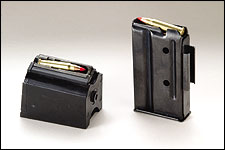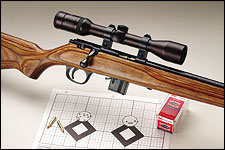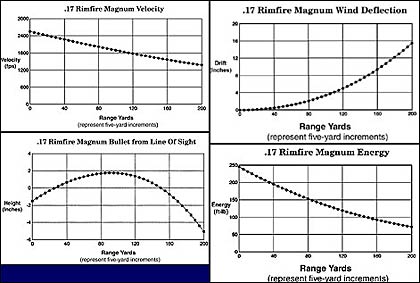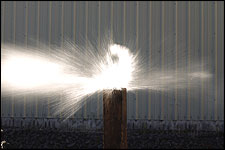January 04, 2011
By Rick Jamison
Our Reloading/Rifles Editor says the .17 HMR cartridge is a real "hummer of a rimfire."
By Rick Jamison
 (L to R) Marlin Model 17VS With Leupold Vari-X III 2.5-8X; Marlin Model 17 V With Swarovski Habicht 3-10X; Ruger Model 17 SRV With Tasco World Class 2-8X. |
Hornady has been quietly making progress toward the hottest commercial rimfire cartridge ever to come along. Shooting a .17-caliber bullet from a necked-down .22 Magnum case, it doesn't look very big and doesn't make a lot of noise, but it spits out a sleek little 17-grain bullet way faster than any rimfire going. And as Hornady gears up to make ammunition, Ruger and Marlin have announced bolt-action rifles to fire it.
So exactly what ballistics does the new round turn up? Hornady reports 2550 fps from a little 17-grain V-Max boattail bullet with a ballistic coefficient (B.C.) of .125.
Advertisement
How does that reporting stack up in the real world? I fired the ammo and found it more than lives up to Hornady's quoted figures. I chronographed 100 rounds from three different rifles--two Marlins and a Ruger--firing 10 10-shot strings over my Oehler system. The instrumental velocity (15 feet from the muzzle) average for all this shooting was 2573 fps, or 23 fps faster than the 2550 muzzle velocity advertised by Hornady. Nine of these groups were fired at 100 yards, and here the B.C. averaged .126, again, slightly better than what Hornady advertised. The B.C. average for 10 shots over 200 yards (one rifle) was .121, or slightly lower than Hornady's B.C. label.
With measured instrumental velocity and time of flight (to find B.C.), the Oehler system then computes muzzle velocity very accurately. The lower B.C. of .121 means that the actual muzzle velocity is 2610 fps, or 60 fps faster than Hornady's advertised figures. This is about 700 fps faster than a standard .22 Magnum rimfire with a standard 40-grain loading, and it is nearly as fast as the .22 Hornet centerfire with a factory 45-grain loading.
Advertisement
As for energy, a true muzzle velocity of 2610 fps with a 17-grain bullet turns up 257 ft-lbs. If you go with Hornady's advertised figures of 2550 fps and .125 B.C., the muzzle energy is 245 ft-lbs, or slightly less than a .22 Magnum.
 The components in Hornady's new .17 HMR loading are 5.6 grains of a spherical-type propellant and the 17-grain V-Max boattail bullet. |
Hornady calls the new rimfire the .17 HMR for Hornady Magnum Rimfire. With an abbreviated name like that, it's natural to call the HMR a real "hummer." It is.
I've been shooting prototype rifles and ammunition for the past few days on targets, expansion medium, and water-filled plastic bottles. The nifty little cartridge in the prototype rifles is one fun cartridge to shoot.
A LITTLE .17 RIMFIRE HISTORY
Development of the ammunition has been a long process. If you're a longtime reader of Shooting Times, you may already be experiencing deja-vu. If you've kept your back issues, take a look at the January 1992 issue for an article called the "Revolutionary .17 Rimfire." In that article I outlined experiments by Steve Chernicky, Terry Kopp, W.A. Eichelberger, A.J. Jones, Fred Wood, and others who have worked on various versions of small caliber rimfires. Shooting Times technical staff member Kopp's round was called the .17 KRM. It fired a 25-grain bullet at 2100 to 2400 fps that was intended to duplicate the performance of the defunct 5mm Remington Magnum. It did so nicely--and then some. Chernicky, on the other hand, went all out for velocity, pushing the limit and eventually getting 2700 fps with lighter 20-grain bullets.
Chernicky had so worked out things to the point that everything went smoothly. The actions had first-class rebarrelings, and the handloads were carefully assembled to .01 grain of powder. With velocity results like that a whole lot of people in the industry were excited about the prospects. I figured it was just a matter of finalizing R&D before we saw ammunition from a major company.
 The Ruger 17 SRV rifle features Ruger's unique rotary magazine (B, L) while the Marlin Model 17V and 17VS both utilize a stack-type magazine. |
As it turned out, the major companies couldn't make ammunition that performed to market expectations at industry standard pressures. Industry standard pressure (to be read as "safe pressure") is the kicker, and being unable to make factory ammunition at industry standard pressure often happens with centerfire cartridge wildcats. A wildcat cartridge produces more velocity than it has any right to. The wildcatter touts the performance of his new round as producing more velocity than any factory offering of similar capacity and even has the chronograph data to prove it. The reality is that he abides by no industry standard pressure limit and has no means to measure pressure. He's added powder until there is sticky extraction or loose primer pockets and then backed off a bit. Some may even have measured case expansion, but the bottom line is the same. Pressures are overboard by industry standards. He has unknowingly exceeded the safe level and is operating in the margin of safety built into rifles and cartridge brass. He doesn't know how far he has intruded into this margin, and he won't know until something disastrous happens.
I'm not knocking wildcatting. I'm speaking in generalities and not about anyone or any specific instance in particular. Kopp and Chernicky are very experienced and know what they are doing. Both use handloading safeguards, and Chernicky had the added advantage of working with a manufacturer who supplied primed empty cases.
 The .17 HMR performed admirably in the Ruger and Marlin rifles, averaging 1.96 inches for three 10-shot groups at 100 yards in the Ruger and 1.36 inches for six 10-shot groups in the Marlin rifles. |
Only recently with Oehler's revolutionary Model 43PBL has the serious individual handloader had the means to get a relative measure on chamber pressure. For many years wildcatting handloaders did the best they could with the tools available. This is one reason why it's called "wildcatting." A
ll this doesn't erase the fact that unless a person has a way to actually measure chamber pressure, he has no idea what it is.
In some respects, rimfire cartridges are even touchier to work with than centerfires. You should never try to pull bullets from rimfire ammunition. And you should never try to reform rimfire cases. It is dangerous. Remember, the priming compound is in the rim, a projection normally used to grip cases in bullet pulling and sizing. You could set a round off.
 |
Besides that, rimfire cases are thin. They're the old folded rim design that centerfire cartridge designers discarded before the turn of the 20th century because they were deemed too weak to handle the pressure of new cartridges. We've been using folded head cases for the small rimfire cartridges because the normal operating pressure is low enough that folded heads work fine for this application. Also, rimfire firearms were designed only for relatively low industry standard pressure. As you can see, the idea of exceeding industry standard pressure is a bad one. It is one thing for an individual to get high velocities in a custom-built firearm held to close tolerances for his own use, and it's another thing entirely for a company to do it with what could become millions of rounds of ammo to be fired in an untold number and type of firearms. Dave Emary, Hornady's chief ballistician and engineer, is one of those guys who thought the cartridge would be a really neat idea and started working with it. As it turned out, a powder is now available that really boosts the velocity performance with this small case. Aside from the powder, cutting the bullet weight to 17 grains gained another significant edge in velocity. But performance with this cartridge is not as simple as lowering bullet weight and increasing the velocity with a new powder.
The Hornady V-Max bullet, with its pointed red tip and boattail, offers a whole new shape with a significantly improved ballistic coefficient. It is much improved over traditional bullet shapes used in rounds like the .22 Magnum or even the now-defunct hot little 5mm Remington Magnum.
Besides all this performance, Hornady's new .17 has the recoil of a pellet gun and what sounds like way less report than a .22 Magnum. (I would say the report is more like a .22 rimfire, though I don't have a way to measure it.) It all adds up to a cartridge that is almost addicting to shoot.
The .17 HMR is also one of the most useful cartridges you can have, particularly if you live in a rural area, as I do. Here, ground squirrels play havoc with the grain bin, starlings make a mess on the hay, nutria cut off acres of crops. And in between, there are tin cans that need shooting. Neighbors don't like to hear a loud rifle. It makes them nervous. Hornady's new .17 is perfect for these conditions.
NEW GUNS FOR THE NEW .17 HMR
The test rifles for this new round were prototypes: a stainless Marlin (called the Model 17VS) in a gray laminated stock (Marlin officials say the production model will come with a black synthetic like the one shown on this month's cover) and topped with a Leupold 2.5-8X scope in Talley mounts; a blued Marlin (Model 17V) in a brown laminated stock carrying a Swarovski 3-10X Habicht scope, also in Talley mounts; and a Ruger, dubbed the 17 SRV (blued steel and walnut stock) and fitted with a Tasco 2-8X World Class scope in Ruger mounts. As I understand it, the Marlin rifles were fitted with custom barrels from Wiseman and Shilen.
 In the animal glue expansion medium, the 17-grain V-Max penetrated two inches at 25 feet, three inches at 100 yards, and four inches at 200 yards. |
All these rifles have bolt actions and detachable box magazines just like .22 Magnum counterpart rifle actions from the same companies. The Ruger has a rotary magazine, and the Marlin has a stackable box. Since you're no doubt familiar with .22 Magnum rifles from these companies, I won't go into detail on them.
The shooting with these rifles is outlined in accompanying charts. You will notice that the groups listed are for 10-shot strings. Tight 10-shot clusters are hard to print. For a big-game gun, I generally figure that if a rifle fires 1.5 inches for 10 shots it is excellent. If you have an off-the-shelf production hunting rifle that groups one inch for 10 shots, don't sell it because you could go years before you find another. As you can see in the charts, both of the Marlin rifles fired 1.0-inch 10-shot strings. In one 10-shot string, the blued-barrel Marlin fired eight shots into 0.8 inch. I have never gotten accuracy this good with any rimfire cartridge, and certainly not with the .22 Magnum.
For three-shot groups, each of the Marlin rifles fired 0.6-inch strings. For five shots, the stainless Marlin fired two strings that measured 1.0 inch and a third that went 0.7. The blued Marlin fired two five-shot strings that measured 1.0 inch.
I moved the target frame to 200 yards to see what the stainless-steel Marlin would do at that distance. Most of the groups were fired with a zero wind condition. Two of them were fired in a two-mph wind. By the time the target frame was set up for the 200-yard shooting, the wind had picked up. My digital display was indicating eight mph with the wind coming from nine o'clock at the beginning of the 10-shot string at 200 yards. There wasn't much time to complete the shooting, and I figured the conditions would provide an indication of what the lightweight .17 bullet would do in the wind.
I was firing from inside my shooting room, and I couldn't hear the wind in my muffs and couldn't feel it on my face. I had no wind flags. In other words, since I couldn't sense the wind, I couldn't dope it. The rifle was simply fired and then the target was examined. Competitive benchrest shooters would call this target a "weather report." The shots were aligned horizontally, 12.5 inches across. I never would have thought the mild breeze would affect the bullet that much. I first wondered if the bore was getting fouled, but there was only about three inches of vertical shot dispersion in the group. It all pointed to the wind. It was a nice little alibi for a 12.5-inch group, but I had to check it out.
I went back to my computer. Using Wayne Blackwell's Load From A Disk, I found that with the muzzle velocity and ballistic coefficient produced by the little bullet, an eight-mph crosswind was worth 12.3 inches of deflection at 200 yards. A five-mph wind would deflect the bullet 7.7 inches at 200 yards, and a 10-mph wind would shift it 15.4 inches. On a normal day here, midday breezes commonly go to 15 mph, which would deflect the bullet 23.1 inches at 200 yards, according to Load From A Disk. At 100 yards, a 15-mph wind would deflect the bullet five inches.
 The .17 HMR really does a number on water-filled plastic jugs. It is tiny in size but big in performance. |
If you want to get good at wind doping with a cartridge that doesn't kick much and doesn't make a lot of noise and you don't have a long firing range, the .17 HMR is a good training vehicle.
The people at Hornady tell me they are getting good 200-yard groups in their tunnel. The rifles and ammo are no doubt capable of it. Due partly to the deadline for this article and partly to the limited ammunition available, I was not able to fire 200-yard groups under ideal conditions. Again, the group I did fire is a weather report and not representative of the accuracy capability of the rifle and ammo. Speaking of recoil, the .17 HMR turns up about 0.2 ft-lbs from the 7.5-pound scoped Ruger. That's not two, it's zero point two. You don't feel any kick at all.
I thought it would be interesting to see how--or if--the tiny little .17-caliber bullet would expand. Using an animal glue expansion medium, I first fired into it from a distance of 25 feet. The velocity on this shot was 2589 fps, and the bullet penetrated two inches into the medium and fragmented as a good varmint bullet would. I recovered a couple of the largest fragments and their combined weight was 5.8 grains. The other fragments were little more than dust particles.
Moving a new block of glue out to 100 yards, the muzzle velocity on this individual shot was 2538 fps. With the acoustic target it is readily possible to get an accurate figure on impact velocity because it picks up time of flight over the shooting distance. I simply placed the acoustic frame in the same plane as the face of the glue expansion medium. The 100-yard impact velocity was 1929 fps, and the bullet penetrated three inches. It mushroomed instead of fragmenting this time and retained 12.2 grains of weight. A good portion of the lead core remained with the jacket.
Moving the target and glue to 200 yards, the muzzle velocity was 2616 fps for the shot, and the system indicated an impact velocity of 1423 fps. The bullet did not expand at this distance though the red tip separated from the rest of the bullet. The tip penetrated 2.50 inches into the medium, and the rest of the bullet penetrated four inches. The retained weight for the bullet and tip was a full 17 grains.
Again, due to limited time and ammo, I fired only one shot into the expansion medium. One shot may not be representative of what is typical. The people at Hornady say they normally get some expansion at 200 yards.
 |
Something you might notice from the accompanying chart was the velocity uniformity. Rimfire cartridges, particularly the .22 Magnum rimfire, are not noted for velocity uniformity. The .17 HMR, however, turned in standard deviation figures that were similar to centerfire cartridge rounds. The .17 HMR ammo is uniform, and this is no small feat. The new Hornady round is loaded with only 5.6 grains of a spherical propellant so a small deviation in charge weight is really a large percentage of variation. In other words, if you're off 0.1 grain in charge weight with a 60-grain charge of powder, it does not mean much. If you're off 0.1 grain in a 5.6-grain charge, it is more than 10 times as significant. Not only is the charge weight small so that the proportion of error is greater, the burning chamber is so much smaller so that errors are emphasized even more. These factors, combined with having to deal with rimfire cartridge priming, are not conducive to a low standard deviation. All this is a roundabout way of saying that the Hornady ammo is good.
So what does the .17 HMR do on game? Unfortunately, I received the rifle too late in the season to go after our ground squirrels. They are sunny-day critters and go in when it's cool and rainy. But starlings were out. A shot to the breast inside 50 yards makes for an exit hole about 1.50 inches in diameter. Needless to say, it makes for a very dead bird. The Germans call it "Maus tot" or "mouse dead," meaning it is killed instantly and drops like a wet rag.
The .17 HMR is not so violent that you couldn't use it on tree squirrels for the frying pan as long as you limited yourself to head shots. The .17 HMR certainly has the accuracy. And at common squirrel shooting distances you will likely get bullet fragments on impact. Tiny fragments don't carry much energy to any distance, and that spells a margin of safety in this regard. This, combined with the low noise, contributes to making it a practical, useful cartridge. Let's face it, some of the wide-open spaces aren't so wide any more. Another thing about the .17 HMR is that the velocity is not so high as to make it a problem bore fouler. While the .17 HMR is hot for a rimfire, it is not hot in the sense of the centerfire .17 Remington that turns in 4000 fps.
The .17 HMR is a great little cartridge with an entirely different purpose. In my book, that purpose is practical. It is a cartridge you can shoot because it won't frighten the neighbors. It is a cartridge with which you can learn to shoot because it is so pleasant and accurate. The ammo is far less expensive than centerfire ammo, and that encourages more shooting--which is the biggest factor to shooting well.
Get yourself one of these little .17s. You'll become addicted.
| .17 HMR Velocity & Accuracy | | Factory Load | Wind Speed (mph) | Average Muzzle Velocity (fps) | High Muzzle Velocity (fps) | Low Muzzle Velocity (fps) | Standard Deviation (fps) | B.C. | 100-Yard Accuracy (inches) | 200-Yard Accuracy (inches) | | Ruger 17 SRV, 22-Inch Barrel, Tasco World Class 2-8X | | Hornady 17-gr. V-Max | 0 | 2596 | 2627 | 2570 | 17 | .126 | 2.10 | -- | | Hornady 17-gr. V-Max | 0 | 2549 | 2579 | 2528 | 17 | .126 | 2.10 -- | | Hornady 17-gr. V-Max | 0 | 2566 | 2605 | 2514 | 26 | .128 | 2.10 | -- | | Marlin 17V, 22-Inch Barrel, Swarovski Habicht 3-10X | | Hornady 17-gr. V-Max | 2 | 2605 | 2623 | 2540 | 24 | .125 | 1.00 | -- | | Hornady 17-gr. V-Max | 2 | 2581 | 2602 | 2558 | 14 | .126 | 1.10 | -- | | Hornady 17-gr. V-Max | 0 | 2548 | 2584 | 2478 | 29 | .128 | 1.40 | -- | | Marlin 17VS, 22-Inch Barrel, Leupold Vari-X III 2.5-8X | | Hornady 17-gr. V-Max | 0 | 2582 | 2616 | 2542 | 22 | .125 | 2.00 | -- | | Hornady 17-gr. V-Max | 0 | 2589 | 2614 | 2555 | 19 | .125 | 1.70 | -- | | Hornady 17-gr. V-Max | 0 | 2545 | 2564 | 2508 | 19 | .125 | 1.00 | -- | | Hornady 17-gr. V-Max | 8 | 2573 | 2622 | 2525 | 24 | .121 | -- | 12.50 |
|
|
